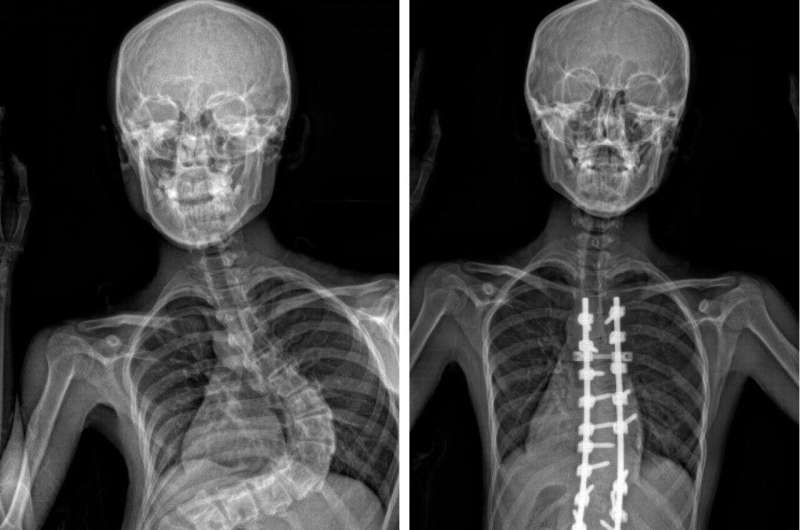This article has been reviewed according to Science X's editorial process and policies. Editors have highlighted the following attributes while ensuring the content's credibility:
fact-checked
trusted source
proofread
Researchers uncover key genetic clue in adolescent idiopathic scoliosis

An interdisciplinary research team led by Professor Jason Cheung Pui-yin from the Department of Orthopaedics and Traumatology, School of Clinical Medicine, has identified a common underlying cause of adolescent idiopathic scoliosis (AIS), the most common form of spinal deformity, which affects millions of adolescents worldwide.
The team discovered that variations in the SLC6A9 gene may cause idiopathic scoliosis, resulting in dysfunction of synaptic neurotransmission and central pattern generators (CPGs). This discovery was published in the Journal of Clinical Investigation.
AIS is a common skeletal disorder characterized by a lateral curvature of the spine exceeding 10 degrees, which affects 3.5% of adolescents aged between 10 and 18 in Hong Kong. It worsens during puberty and can result in various complications, including impaired cardiopulmonary functions, shortness of breath, back pain, uneven shoulders and hips, and overall poor cosmesis.
These physical challenges can impact the social and psychological well-being of the affected individuals. Currently, treatment options are limited to bracing and invasive surgery after the condition develops. Preventive interventions remain unavailable, and their etiology is uncertain.
Research methods and findings
The research team investigated the genetic basis and pathogenic mechanism of AIS with a combined 1,701 AIS patients and 3,219 controls from the University of Hong Kong, Texas Scottish Rite Hospital for Children, and Peking Union Medical College Hospital in Beijing. They identified rare variants in the SLC6A9 gene, responsible for producing a protein called glycine transporter 1 (GLYT1), which can lead to disruptions in the transmission and coordination of nerve signals.
GLYT1 plays a crucial role in regulating glycine levels in the body, which is essential for proper nerve signaling in the spine.
The team revealed that these identified variants in SLC6A9 resulted in reduced glycine uptake activity, leading to an increased glycine level and aberrant glycinergic neurotransmission. To further validate their findings, the team developed a novel zebrafish model with a disrupted SLC6A9 gene, mirroring the gene changes observed in humans with AIS. The mutant zebrafish exhibited spinal curvature and discoordination of spinal neural activity, resembling the symptoms found in AIS patients.

The team also investigated the role of CPGs, which are neural circuits in the spinal cord responsible for generating rhythmic movements, such as walking or breathing. They discovered that excessive glycine, caused by mutant GLYT1, may interfere with the normal function of CPGs, potentially contributing to the development of AIS.
In a further exploration of potential preventive therapies, the team tested sodium benzoate, a glycine neutralizer used clinically to treat patients with glycine encephalopathy, on the mutant zebrafish. The results showed that sodium benzoate can moderately reduce the severity of curvature in zebrafish, suggesting that it could provide a potential preventive therapy for AIS patients with high glycine levels.
AIS cases
Among the patients involved in the study, Miss Lam and Miss Law were particularly instrumental in the success of the research. Both of them experienced severe scoliosis during their teenage years and underwent surgical correction of their scoliosis deformities at the Duchess of Kent Children's Hospital.
Subsequently, 61% of Miss Lam's family and 50% of Miss Law's family also developed scoliosis, several of whom required surgical intervention. This SLC6A9 mutation carries an autosomal dominant pattern, which was found in the many involved members of their families.
AIS lacks an agreed-upon etiology, impeding early intervention. While genetic factors are known to play a significant role in the development of AIS, the heritability and causal mechanisms remain unclear.
"Our research efforts to identify AIS-related genetic variants can help fill the gaps, leading to targeted treatments and personalized medicine for AIS," said Professor Jason Cheung Pui-yin, Chairperson and Clinical Professor of the Department of Orthopaedics and Traumatology, School of Clinical Medicine, HKUMed.
This discovery by the HKUMed research team not only sheds light on the genetic factors contributing to AIS but also paves the way for the development of new diagnostic methods and potential preventive therapies. "With further research and clinical trials, the findings may revolutionize the management of AIS and greatly improve the lives of adolescents affected by this condition," added Professor Cheung.
More information: Xiaolu Wang et al, Impaired glycine neurotransmission causes adolescent idiopathic scoliosis, Journal of Clinical Investigation (2023). DOI: 10.1172/JCI168783


















